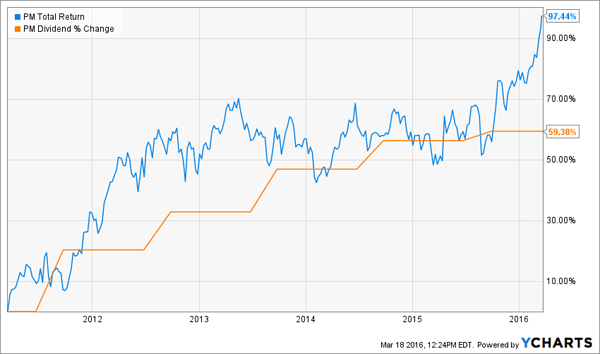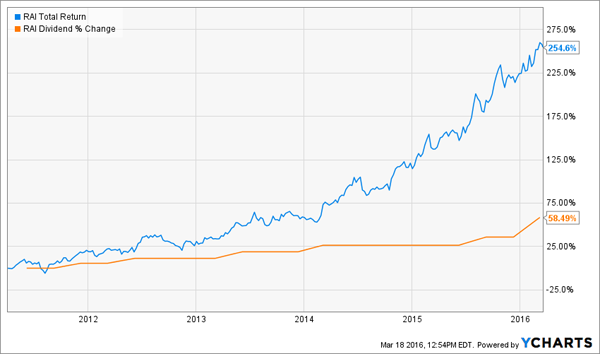Vice pays if you’re an investor. You’ll earn higher yields and returns investing in booze, tobacco, firearms, and gambling than you will in feel-good stories like clean energy.
“First-level” investors tend to avoid these types of stocks. As a result, they’re often cheap.
For example, you may think smoking is a fading habit. But even today, one in six Americans still smoke. Despite the warning labels, the public campaigns, and a concerted effort to ban smoking in most public places, some folks still just want a cigarette.
And since smokers are going to keep smoking, we should consider the perennial dividend growers who profit from the sustainability of cigarettes. Here are my three favorites…
Three Rising Dividend Yields From Cigarettes
Philip Morris International Inc. (PM) sells a range of tobacco, nicotine and cigarettes globally. Philip Morris pays a $4.08 dividend that yields 4.1%. The company has increased its dividends eight times since being spun out from Altria Group (MO) in 2008. The stock hit a new all-time high this week.
Flip Mo’s Rising Dividend Powers 97% Gains

PM is up 12.5% year-to-date, and up an impressive 27.4% over the last year.
The company has a high dividend payout ratio, returning 91.4% of its earnings. I usually require payout ratios under 50%, but this company is a cash machine that doesn’t require much reinvestment.
Vector Group Ltd (VGR) manufactures and sells e-cigarettes. Unlike traditional cigarettes, e-cigarettes are battery powered and give the sensation of smoking through vapor.
The company is a potential takeover candidate for one of the larger firms looking to get into the booming “e-cig” business. Its $3 billion market cap could be easily swallowed by a giant like Phillip Morris or an overseas suitor.
Vector pays a $1.60 dividend that yields 7%. The company has increased its dividends four times over the last 5 years. The stock is down just 2.5% for the year-to-date, but is up over 7.5% for the last year.
Vector looks great, except for its 328% payout ratio. The company has a large cash reserve it’s paying from. This is fine for the short term, but we’ll eventually want to see profits grow to entirely cover the payout.
Finally Reynolds American, Inc. (RAI) is a holding company for three segments which produce and sell tobacco and snuff products. RAI is paying a $1.68 dividend that yields 3.3%. This was up 16.7% last year. The company has increased its dividends six times in the last five years.
The stock had a two-for-one split in 2015. While a stock split does nothing to your equity value in the short-term, the increased share amounts and lower prices have a positive longer-term effect of enticing more buyers and keeping the liquidity up.
The stock is up 9.8% YTD, and up a stunning 45.1% over the last year.
Reynolds Rallies

With the recent run up in these stocks, you should wait for a pullback before you consider buying. If you’re looking to put new money to work now, I’d take the “other side” of this trade and purchase a healthcare stock with a growing dividend.
Healthcare is cheap thanks to election worries. And no matter what happens in November, my favorite company’s business model is bullet proof. It’s based on the surest economic bet in America:
The country will be older in the future than it is now, and demand for healthcare services is set to skyrocket.
In fact, by 2024, national healthcare expenditures are expected to climb to $5.43 trillion, or about 20% of GDP. This firm is capitalizing on this trend, and growing its already-big 6.8% dividend literally every 3 months. Plus, shares have easy 20% upside from here or better, as they’re trading for just 10-times cash flow.
This dividend grower already pays a gaudy 6.8% today.And it increases its payout not just every year, but every single quarter. If you buy shares today, you’ll be earnings a 10%+ cash yield on your initial investment in no time.
